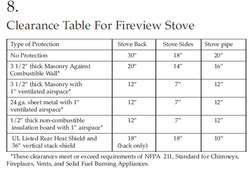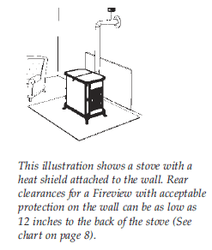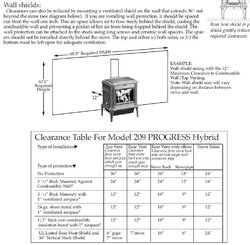Ok - I'm considering an install that would require a shield on one side for clearance. I know the basic rules (1" air gap, non-combustible materials, open on top and bottom for free flow). What I would like to ask the forum gurus (and others too) is really two things.
1) Does the shield have to go floor to ceiling or just cover the section of the wall to the side of the stove? i.e. if the stove is x feet tall, then does the shield just have to be the same x feet high? Same question to width - how far forward/back up/down does it need to extend? I imagine you can't just match the dimensions of the side of the stove and go stick a piece of sheet metal like a shadow on the wall - or could you (if one were so inclined?).
2) This is the more fun one... Since I am looking at this from the side, I'm looking for ideas/suggestions on how to build one that would look nice (pass the "wife" test with flying colors) as well as be reasonably easy to assemble. Our walls are all painted plaster and to make it more complex, there is a 'chair rail' made of wood that runs along all the walls as the room used to be a small dining room. So what could be used to make this look nice from both the side as well as the front faces with minimal complexity? Really can't expect an industrial look to pass muster here.
Thanks in advance.
1) Does the shield have to go floor to ceiling or just cover the section of the wall to the side of the stove? i.e. if the stove is x feet tall, then does the shield just have to be the same x feet high? Same question to width - how far forward/back up/down does it need to extend? I imagine you can't just match the dimensions of the side of the stove and go stick a piece of sheet metal like a shadow on the wall - or could you (if one were so inclined?).
2) This is the more fun one... Since I am looking at this from the side, I'm looking for ideas/suggestions on how to build one that would look nice (pass the "wife" test with flying colors) as well as be reasonably easy to assemble. Our walls are all painted plaster and to make it more complex, there is a 'chair rail' made of wood that runs along all the walls as the room used to be a small dining room. So what could be used to make this look nice from both the side as well as the front faces with minimal complexity? Really can't expect an industrial look to pass muster here.
Thanks in advance.


 In this case the clearance is 24" required and I'll have about 21.75" to the wall so I expect that would put me adding about 1.1" additional border on the shield (or 2.2" total added to the width and height if centered) as a minimum. Not a huge added size here. Side of the stove is 35.5" x 25" making my minimum shield size about 38"x27.5" if well placed. Wonder how that would look with painted sheet metal, not a huge amount of support required for that small a piece I would think.
In this case the clearance is 24" required and I'll have about 21.75" to the wall so I expect that would put me adding about 1.1" additional border on the shield (or 2.2" total added to the width and height if centered) as a minimum. Not a huge added size here. Side of the stove is 35.5" x 25" making my minimum shield size about 38"x27.5" if well placed. Wonder how that would look with painted sheet metal, not a huge amount of support required for that small a piece I would think. However at least I know now. Interestingly it is wider than my wall so at least that limits things a bit. It is 98.5" wide by 67.5" high per spec. Yuck. Now to figure out what to make it out of and cover it with etc.
However at least I know now. Interestingly it is wider than my wall so at least that limits things a bit. It is 98.5" wide by 67.5" high per spec. Yuck. Now to figure out what to make it out of and cover it with etc.


